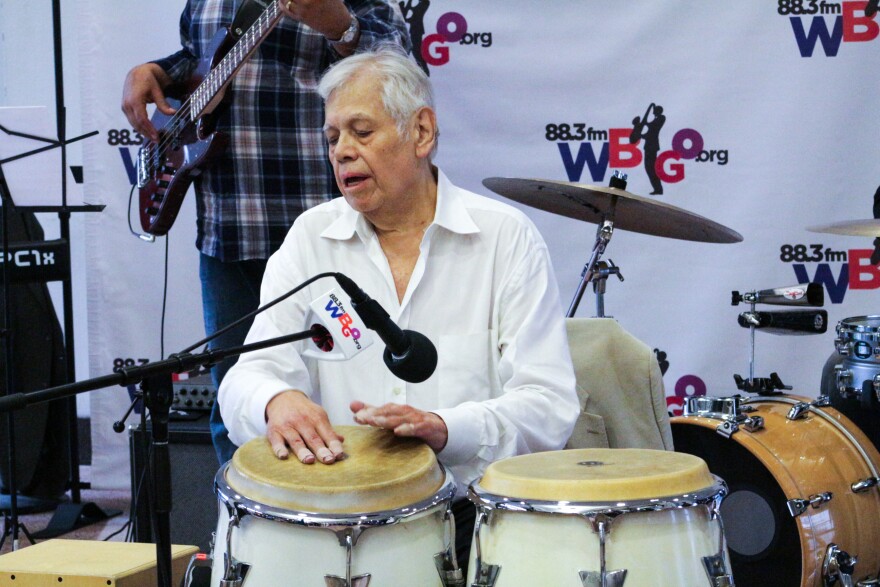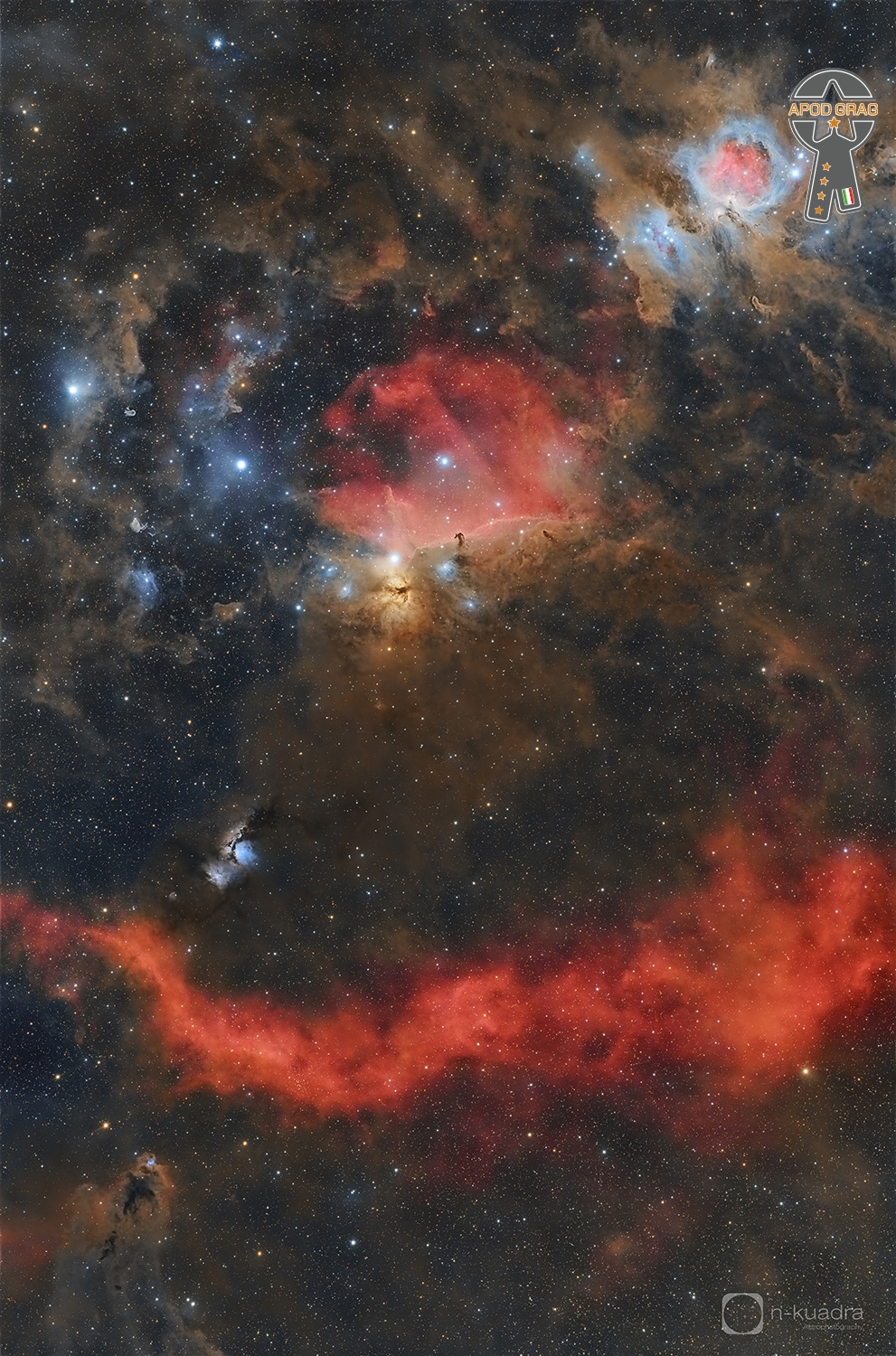Blog
Junior Marvin (born Donald Hanson Marvin Kerr Richards Jr., June 22, 1949), also known as Junior Marvin-Hanson, Junior Hanson, Junior Kerr, and Julian Junior Marvin, is a Jamaican-born guitarist and singer best known for his association with Bob Marley and The Wailers. He started his career as Junior Hanson with the band Hanson in 1973. Marvin has also been associated with Gass, Keef Hartley Band, Toots & the Maytals and Steve Winwood.
Born in Kingston, Surrey County, Jamaica, Marvin moved to London as a child, where his love of both acting and music was nurtured. He appeared in the Beatles’ film Help!, which was followed by a number of television appearances. Meanwhile, Marvin served his musical apprenticeship in the United States by playing with those including T-Bone Walker and Ike & Tina Turner. Back in England, he played with bands such as Herbie Goins & the Nighttimers, Blue Ace Unit and White Rabbit.
more...Hermeto Pascoal (born June 22, 1936) is a Brazilian composer and multi-instrumentalist. He was born in Lagoa da Canoa, Alagoas, Brazil. Pascoal is best known in Brazilian music for his orchestration and improvisation, as well as for being a record producer and contributor to many Brazilian and international albums.
more...Raymond Mantilla (June 22, 1934 – March 21, 2020) was an American percussionist.
Mantilla played on hundreds of recordings, including some that have become important parts of jazz history, like Max Roach’s M’Boom, Herbie Mann’s Flute, Brass, Vibes and Percussion and Charles Mingus’s Cumbia & Jazz Fusion. He was one of the three most recorded conga players in the history of jazz; he held that distinction with Ray Barretto and Cándido Camero.
Like Cándido, one of his heroes, Mantilla championed the use of multiple congas, employing up to four drums at times, each tuned to a specific pitch. Also like Cándido, he championed the performance of solo pieces on congas.
But Mantilla was, as he liked to put it, the complete percussionist — skilled not only on congas but also a range of other instruments. “I loved the way Ray played charanga-style timbales,” Barretto once said. “Remember, you have only one bell to keep time accompanying the flute and violins, and you have to play rock-solid time with swing.”
Mantilla described his own music as “Latin Jazz with authentic Latino rhythms.” He released nine albums as a leader. His first was Mantilla, in 1978, and his most recent was High Voltage, almost 40 years later. He recorded a follow-up, Rebirth, scheduled for release this year on Savant Records.
“It’s a combination of the familiar and the eclectic,” said longtime Mantilla associate Mike Freeman, who plays vibraphone on that album. The title, Rebirth, he explained, “is a reference to Ray surviving cancer two years ago.”

Raymond Mantilla was born in St. Francis Hospital in the South Bronx on June 22, 1934. His father, Carlos Mantilla Ghilardi, was an architect and engineer who was recruited to work on the building of the George Washington Bridge. He then began working for the U.S. Intelligence Services in a branch in Peru, just before the United States’ entry into World War II. Ray’s mother, Ramona Maldonado, hailed from the city of Vega Baja in Puerto Rico, and owned and operated a bodega in the South Bronx.
Ray’s childhood friends included some of the major forces in the Afro-Cuban music scene that became redefined by New York’s City’s Puerto Rican community into what we know as salsa. Among them were timbalero Orlando Marin, percussionist Manny Oquendo, pianist Eddie Palmieri, flutist and percussionist Johnny Pacheco, and percussionist Benny Bonilla.
Bonilla, who played timbales on the seminal Latin Boogaloo hit “I Like It Like That,” met Mantilla at age 15. “He and I would practice our conga beats to 78 vinyl records,” he said. “Ray stressed a steady and good left hand.”
But Mantilla’s closest childhood friend was Barretto, a pioneering conga player who became an NEA Jazz Master in 2006, one month before his death at 76. “Me and Ray were like peas in a pod,” Mantilla once recalled. “He got me into the studios, since he would send me to cover dates he couldn’t do. Between Ray, Johnny Pacheco, Willie Rodriguez, Cándido, and me, we were doing all the Latin percussion work on studio sessions in New York.”

Barretto also made a fateful introduction when he recommended Mantilla to Mann, a flutist leading a widely popular Latin jazz band. Barretto and Mantilla played together on a handful of albums by Mann at the dawn of the ‘60s, including The Common Ground and The Family of Mann — but by the time of Herbie Mann at The Village Gate in ’61, Barretto had moved on, and given Mantilla his blessing.
His work with Mann, and his association with Barretto, brought Mantilla to the attention of prominent jazz bandleaders like Mingus, Roach, Art Blakey and many more. “I always liked the freedom in jazz and I dug the scene as well,” he said. “You could be more creative, looser. After a while I just stopped doing gigs on the Latin scene altogether unless I was called as a guest soloist.”
In 1972, Mantilla was asked to join Roach’s percussion ensemble M’Boom, which had been formed two years earlier. “I was impressed by Ray when I saw him with Art Blakey because I liked the way he navigated his role in the group,” recalls founding member Joe Chambers, who recommended him for the gig. “He demonstrated the drummer’s philosophy as it was taught to me, to accompany. He never overplayed.”
Warren Smith, another member of M’Boom, recalls: “Ray understood the subtle nuances in African, Latin, and jazz-based music and he adapted beautifully. The first time he played with us it was seamless. What also impressed me was the variety of solo contexts he could do. He could play solo on bongos, congas, whatever, and hold the audience. He was also funny as an emcee. When we performed in Barcelona, Max let him speak to the audience in Spanish. He had them in the palm of his hand introducing each one of us with funny quips and jokes.”
For Mantilla, M’Boom was an opportunity to expand his musicianship. “I had to learn to play mallet parts on vibes, xylophone, etc. I had never done that before. It was great. They showed me that and I had a chance to show the guys how to play hand drums and the percussion in an authentic way.”
In 1977, Mantilla also made political history, as part of a group of musicians led by Dizzy Gillespie who became the first to perform in Cuba since the travel embargo of 1962. Their joint concerts with Cuba’s supergroup Irakere and the rúmba percussion ensemble Los Papines would reestablish musical ties with the island.
It was the following year, 1978, that Mantilla really became a bandleader. His group, which he eventually dubbed the Space Station, explored Afro-Cuban-based rhythms but also experimented with expanding the parameters of the music, notably with odd meters. “I was into that when nobody else was, other than people like Don Ellis,” Mantilla said. “That’s why on that album you hear things in seven, etc. Nobody in Latin jazz was doing that at all. That’s why I would call the group Space Station. We were doing things that were out of the norm.”

Trumpter Guido Gonzalez spoke to Mantilla’s style as a bandleader: “In many ways Ray was like Art Blakey. He’d let everyone in the band give their input. He was also funny. The way I got in the band was after I played in a rehearsal, he came up to me and said, ‘Man, your sound doesn’t bother me.’”
more...Katherine Mary Dunham (June 22, 1909 – May 21, 2006) was an American dancer, choreographer, anthropologist, and social activist. Dunham had one of the most successful dance careers of the 20th century and directed her own dance company for many years. She has been called the “matriarch and queen mother of black dance.”
While a student at the University of Chicago, Dunham also performed as a dancer, ran a dance school and earned an early bachelor’s degree in anthropology. Receiving a postgraduate academic fellowship, she went to the Caribbean to study the African diaspora, ethnography and local dance. She returned to graduate school and submitted a master’s thesis to the anthropology faculty. She did not complete the other requirements for that degree, however, as she realized that her professional calling was performance and choreography.
At the height of her career in the 1940s and 1950s, Dunham was renowned throughout Europe and Latin America and was widely popular in the United States. The Washington Post called her “dancer Katherine the Great.” For almost 30 years she maintained the Katherine Dunham Dance Company, the only self-supported American black dance troupe at that time. Over her long career, she choreographed more than ninety individual dances. Dunham was an innovator in African-American modern dance as well as a leader in the field of dance anthropology, or ethnochoreology. She also developed the Dunham Technique, a method of movement to support her dance works.
Katherine Mary Dunham was born on the 22 of June in 1909 in a Chicago hospital. Her father, Albert Millard Dunham, was a descendant of slaves from West Africa and Madagascar.
more...Erev Shabbat Pride Service with Guest Speaker Jae Bates
Friday 6-21-24 Music with Inbal Sharett-Singer, Jayson Rodovsky, Jeff Bailey, Pete Whitman and mick LaBriola.
more...Returning to science operations on June 14, the Hubble Space Telescope used its new pointing mode to capture this sharp image of spiral galaxy NGC 1546. A member of the Dorado galaxy group, the island universe lies a mere 50 million light-years away. The galactic disk of NGC 1546 is tilted to our line-of-sight, with the yellowish light of the old stars and bluish regions of newly formed stars shining through the galaxy’s dust lanes. More distant background galaxies are scattered throughout this Hubble view. Launched in 1990, Hubble has been exploring the cosmos for more than three decades, recently celebrating its 34th anniversary.

Nils Hilmer Lofgren (born June 21, 1951) is an American rock musician, recording artist, songwriter, and multi-instrumentalist. Along with his work as a solo artist, he has been a member of Bruce Springsteen‘s E Street Band since 1984, a member of Crazy Horse, and founder/frontman of the band Grin. Lofgren was inducted into the Rock and Roll Hall of Fame as a member of the E Street Band in 2014. Lofgren was born in Chicago, Illinois, United States, to an Italian mother and a Swedish father. When he was a young child, the family moved to the Washington, D.C., suburb of Bethesda, Maryland. Lofgren’s first instrument was classical accordion, beginning at age five, which he studied seriously for ten years. After studying classical music and jazz, throughout his youth, Lofgren switched his emphasis to rock music, and focused on the piano and the guitar.
more...Maria Rosa Marco Poquet (Catalan pronunciation: [məˈɾi.ə ˈrɔzə ˈmaɾku puˈkɛt]; born 21 June 1939), better known by her stage name
Salomé (Catalan: [səluˈme], Spanish:[saloˈme]), is a Spanish singer.
Salomé was born in Barcelona, Spain. She was one of the four winners of the Eurovision Song Contest 1969 with the song “Vivo cantando“.
She began her career in Radio Barcelona. Since then, she has continued her musical career combining it with television appearances as hostess. She has performed as opening act for Frank Sinatra. By 1963 she had recorded more than forty songs for record companies Iberofón and Zafiro. In 1963 she won the 5th Festival de la Canción Mediterránea de Barcelona music contest with her song in Catalan, “Se’n va anar.
more...Boris Claudio “Lalo” Schifrin (born June 21, 1932) is an Argentine-American pianist, composer, arranger, and conductor. He is best known for his large body of film and TV scores since the 1950s, incorporating jazz and Latin American musical elements alongside traditional orchestrations. He is a five-time Grammy Award winner; he has been nominated for six Academy Awards and four Emmy Awards.
Schifrin’s best known compositions include the themes from Mission: Impossible and Mannix, as well as the scores to Cool Hand Luke (1967), Bullitt (1968), THX 1138(1971), Enter the Dragon (1973), The Four Musketeers (1974), Voyage of the Damned(1976), The Eagle Has Landed (1976), The Amityville Horror (1979), and the Rush Hourtrilogy (1998–2007). Schifrin is also noted for his collaborations with Clint Eastwoodfrom the late 1960s to the 1980s, particularly the Dirty Harry series of films. He composed the Paramount Pictures fanfare used from 1976 to 2004.
In 2019, he received an honorary Oscar “in recognition of his unique musical style, compositional integrity and influential contributions to the art of film scoring.”
more...The Orion constellation is a celestial treasure. It houses iconic nebulae such as the Horsehead and Flame, the Boogeyman, m78 among many others, highlighting the complexity of star formation. The three stars of Orion’s belt, together with the Orion Nebula, complete this captivating astronomical setting. Its cosmic wonders invite you to explore the richness and beauty of the nocturnal universe.

Chester Burton Atkins (June 20, 1924 – June 30, 2001 Luttrell, Tennessee), also known as “Mr. Guitar” and “The Country Gentleman“, was an American musician who, along with Owen Bradley and Bob Ferguson, helped create the Nashville sound, the country music style which expanded its appeal to adult pop music fans. He was primarily a guitarist, but he also played the mandolin, fiddle, banjo, and ukulele, and occasionally sang.
Atkins’s signature picking style was inspired by Merle Travis. Other major guitar influences were Django Reinhardt, George Barnes, Les Paul, and, later, Jerry Reed.His distinctive picking style and musicianship brought him admirers inside and outside the country scene, both in the United States and abroad. Atkins spent most of his career at RCA Victor and produced records for the Browns, Hank Snow, Porter Wagoner, Norma Jean, Dolly Parton, Dottie West, Perry Como, Floyd Cramer, Elvis Presley, the Everly Brothers, Eddy Arnold, Don Gibson, Jim Reeves, Jerry Reed, Skeeter Davis, Waylon Jennings, Roger Whittaker, Ann-Margret and many others.
Rolling Stone credited Atkins with inventing the “popwise ‘Nashville sound’ that rescued country music from a commercial slump” and ranked him number 21 on their list of “The 100 Greatest Guitarists of All Time”. In 2023, Atkins was named the 39th best guitarist of all time. Among many other honors, Atkins received 14 Grammy Awards and the Grammy Lifetime Achievement Award. He also received nine Country Music Associationawards for Instrumentalist of the Year. He was inducted into the Rock and Roll Hall of Fame, the Country Music Hall of Fame and Museum, and the Musicians Hall of Fame and Museum. George Harrison was also inspired by Chet Atkins; early Beatles songs such as “All My Loving” show the influence.
more...Eric Allan Dolphy Jr. (June 20, 1928 – June 29, 1964) was an American jazz multi-instrumentalist and bandleader. Primarily an alto saxophonist, bass clarinetist, and flautist, Dolphy was one of several multi-instrumentalists to gain prominence during the same era. His use of the bass clarinet helped to establish the unconventional instrument within jazz. Dolphy extended the vocabulary and boundaries of the alto saxophone, and was among the earliest significant jazz flute soloists.
His improvisational style was characterized by the use of wide intervals, in addition to employing an array of extended techniques to emulate the sounds of human voices and animals. He used melodic lines that were “angular, zigzagging from interval to interval, taking hairpin turns at unexpected junctures, making dramatic leaps from the lower to the upper register.” Although Dolphy’s work is sometimes classified as free jazz, his compositions and solos were often rooted in conventional (if highly abstracted) tonal bebop harmony.
Dolphy was born and raised in Los Angeles. His parents were Sadie and Eric Dolphy, Sr., who immigrated to the United States from Panama. He began music lessons at age six, studying clarinet and saxophone privately. While still in junior high, he began to study the oboe, aspiring to a professional symphonic career, and received a two-year scholarship to study at the music school of the University of Southern California. On June 27, 1964, Dolphy traveled to Berlin to play with a trio led by Karl Berger at the opening of a jazz club called The Tangent.He was apparently seriously ill when he arrived, and during the first concert was barely able to play. He was hospitalized that night, but his condition worsened. On June 29, Dolphy died after falling into a diabetic coma. While certain details of his death are still disputed, it is largely accepted that he fell into a coma caused by undiagnosed diabetes. The liner notes to the Complete Prestige Recordings box set say that Dolphy “collapsed in his hotel room in Berlin and when brought to the hospital he was diagnosed as being in a diabetic coma. After being administered a shot of insulin he lapsed into insulin shock and died”.
more...More Posts
- Ernestine Anderson
- Mose Allison
- World Music with Nation Beat
- Daily Roots with Tarrus Riley
- Surviving the Pandemic and Realizing Racial Justice
- The Cosmos with IC 1848
- Russell Means
- Big Chief Ellis
- Hubert Laws
- Paul Bley
- Carl W Stalling
- World Music with Elida Almeida
- Daily Roots with Desmond Dekker
- Surviving the Pandemic and Realizing Racial Justice
- The Cosmos with Aurora over Norway
- Mary Travers
- Lynn Baker
- Mezz Mezzrow
- World Music with Cándido Camero Memorial
- Daily Roots with the Mighty Diamonds


